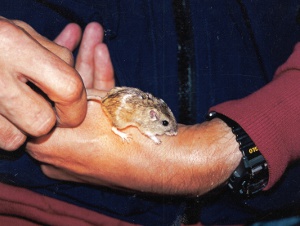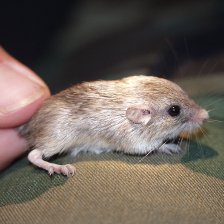In response to the environmental consequences of burning fossil fuels, particularly climate change, and rising energy prices, alternative energy sources are being actively sought throughout the world. Renewable energy sources can help to meet growing energy demands while reducing environmental costs. One widely promoted alternative is biomass energy derived from dedicated biomass crops, as well as from forest and fire management activities. While biomass energy shows some promise as a clean, renewable, and domestic alternative to fossil fuels, it can conflict with critical ecological values and sustainability goals if not properly planned for and implemented. In order to move toward ecological sustainability, biomass energy production must not degrade these important ecological values. However, existing projections of available forest and shrubland biomass resources in the U.S. have not adequately taken these values into consideration.
The Natural Resources Defense Council (NRDC) commissioned CBI to evaluate the effect that ecological constraints would have on estimates of forest and shrubland biomass resources available for energy production in California, as assessed by the California Energy Commission in 2005. California, home to many biologically diverse and unique areas, has been a leader in developing biomass as a potential source of energy as the demand for electrical power continues to rise. The current contribution from biomass to electrical power in California is very small, but current and future biomass resources could be effectively developed to contribute as much as 15 percent of electrical energy demands by 2020. Rapid development of biomass as an energy alternative in California and elsewhere without careful consideration of the overall environmental impact could help achieve climate change abatement goals on the one hand but devastate important biological and ecological values on the other. Accounting for these effects is an initial step towards reducing the environmental impact and risk to important conservation values as biomass development planning and implementation moves ahead. Using available spatial datasets, CBI’s GIS-based analysis quantified and mapped the changes to the current forest and shrubland biomass estimates after accounting for ecological values, such as old growth forest and critical habitat, and the wildland-urban interface.
The IABIN Data Integration and Analysis Gateway (DIAG) is a gateway within Data Basin that provides a custom view of content in the system for IABIN users. This gateway is intended to showcase the information produced by the 5 IABIN thematic networks: ecosystems, invasive species, pollinators, protected areas, and species & specimens.
IABIN was created in 1996 as an initiative of the Santa Cruz Summit of the Americas meeting of Heads of State. Steadily gaining momentum, there are now 34 countries in the Americas that have officially been named IABIN focal points. Although endorsed by governments, NGOs, universities, museums, and the private sector all belong to and play important roles in IABIN.
IABIN will provide the networking information infrastructure (such as standards and protocols) and biodiversity information content required by the countries of the Americas to improve decision-making, particularly for issues at the interface of human development and biodiversity conservation. It is developing an Internet-based platform to give access to scientifically credible biodiversity information currently scattered throughout the world in different institutions, such as government organizations, museums, botanical gardens, universities, and NGOs.
The IABIN Secretariat is dedicated to the implementation of IABIN will support a technical standards development process, coordinate catalogues and directories (either centralized or distributed), manage communications including electronic mailing, lists and Web sites, coordinate efforts with other networks, support training for member countries and organizations, and support the efforts of IABIN nodes.
All content developed by IABIN is open and available for public use.
The World Wildlife Fund has identified over 200 ecoregions (the Global 200) recognized for their high conservation priority, and calls for concentrated conservation planning in these regions. Not surprisingly, forested ecoregions constitute the majority of the Global 200.
Humans associate a wide array of values with forests. Historically, human interaction with forests has been predominantly destructive. Among the most important of these include:
- Conversion due to urbanization, agriculture, ranching, and mining
- Commercial exploitation of timber and wood pulp
- Local exploitation for firewood
- Human-altered distribution regimes (e.g. fire)
- Introduction of exotic species
- Construction of infrastructure facilities – particularly roads
Consequently, long-term forest conservation depends, at least in part, on large-scale forest restoration. The purpose of this report is threefold:
- Discuss the concept of forest restoration form a conservation biology perspective
- Outline the ecological characteristics, technical constraints, socio-political and economic influences, and overall restoration principles relevant to the Global 200 major habitat types and associated realms
- Place forest restoration within the larger context of worldwide forest conservation
The Forest Intactness Database was the result of a collaborative effort between the Conservation Biology Institute, theWorld Wildlife Fund U.S., and the World Resources Institute’sGlobal Forest Watch. Using primarily Landsat TM based National Land Cover Data (NLCD) and 1:100,000 scale USGS road data sets, we assessed relative forest intactness for 39 forested ecoregions of the coterminous United States.
Forest intactness was mapped within “landunits” that were defined by highways and urban areas that contained more than 50,000 people. For each landunit, road density was calculated as well as a suite of class and landscape level fragmentation metrics using FRAGSTATS, a spatial analysis software program. For each landunit, road density, class area, percentage of landscape, total core area index, and mean nearest neighbor results were assigned ordinal scores from which a cumulative score was calculated to create an overall relative forest intactness score. By assigning all landunits with a quantitative measurement of relative forest intactness based on a uniform dataset, this study:
(1) Identified remaining relatively intact forest
(2) Identified landunits that may make good restoration candidates from a regional context
(3) Examined forest fragmentation due to roads which has been omitted from other recent national assessments.
The Conservation Biology Institute, through a grant from the David and Lucille Packard Foundation, is working with BLM, CDFG, and USFWS to develop a science-based regional planning framework for the high wind resource region of the eastern Tehachapi Mountains and southeastern Sierra. The project is intended to facilitate decision-making on a regional basis, per the recent federal guidance policies, through spatially-explicit and transparent decision-support tools for wind energy development and conservation.
We assembled available spatial datasets related to biodiversity and landscape intactness, developed logic and associated thresholds, and ranked sections of land (640 acres/1 Sq. mile), according to ecological value, biological potential, and level of disturbance. CBI has created web-based tools for visualizing the results, which are transparent, flexible, and supportive of agency needs. The results are being used to map priority areas for conservation and where renewable energy projects and associated infrastructure may be compatible with conservation goals.
Implemented for the Southern Sierra/Western Mojave, the approach and decision-support tool have widespread applicability, including:
- Informing conservation goals
- Setting priorities for regional reserve design and off-set mitigation
- Informing resource management needs
- Identifying priority information gaps
- Prioritizing conservation of unprotected lands
- Providing a process for transparent risk assessments by developers and permit agencies
- Identifying potential conflicts with development
The title of this project was formerly “Wind, Wings & Wilderness”
Click here for the final project report.
The critically endangered Pacific pocket mouse (Perognathus longimembris pacificus), once thought extinct was rediscovered at 4 sites along the coast of southern California during the 1990s. CBI staff discovered one of the populations and led comprehensive efforts to identify all potential habitat areas and inform efforts to recover the species from the brink of extinction. Tasks included:

1) Studying dispersal characteristics and other pertinent biological information on the species
2) Performing detailed field studies of a surrogate subspecies to perfect field methods and design monitoring programs
3) Determining the feasibility of a translocation or reintroduction program for the species, determining baseline measures of genetic diversity within and between extant (using live-captured specimens) and historic (using museum specimens) populations and developing genetic goals for the recovery program
4) Coordinating ongoing monitoring studies at extant population sites to maximize the value of the monitoring data for both scientific and preserve management goals
Partners include Transportation Corridor Agencies, U.S. Fish and Wildlife Service, and California Department of Fish and Game.
Photo credits: Steve Montgomery (juvenile above) and David King (1995, Camp Pendleton)
CBI provides scientific guidance for a wide variety of regional conservation plans, including:
- Habitat Conservation Plans (HCP)
- Natural Community Conservation Plans (NCCP)
- Endangered Species Recovery Plans
- Adaptive Management and Monitoring Plans
CBI staff organizes and facilitates panels of scientific experts and writes and edits science advisory reports that provide guidance for large-scale conservation plans. In California, these have included the Desert Renewable Energy Conservation Plan, the Sacramento-San Joaquin Bay Delta Conservation Plan, the Altamont Pass Wind Resource Area Conservation Plan, and NCCP/HCP plans for the counties of Butte, Santa Clara, San Diego, Merced, Yuba, Sutter, and Yolo, and the city of Santa Cruz.
CBI staff are leading a large team of mammal experts in preparing a comprehensive review of the conservation status of all mammal species, subspecies, and distinct population segments in California. The team has developed and applied a systematic scoring procedure to rank mammal species, subspecies, or distinct population segments for their relative degree of conservation concern within California. They compiled all available locality data and other pertinent information concerning the status and distribution of nominee taxa, and are preparing species accounts and geographic range maps for each taxon that made the final list. The result will be used to update Department of Fish and Game’s official list of sensitive taxa and will be published in book and web formats.
Click here to access the Mammal Species of Special Concern (MSSC) website

Photo credit: Steve Montgomery
CBI staff verified a new population of the endangered Stephens’ kangaroo rat in the Santa Maria Valley, San Diego County, California, by trapping and reconnaissance surveys and performed numerous adaptive management and monitoring tasks to help sustain this isolated population. Tasks included:
- Mapping the density and extent of population
- Performing GIS habitat modeling to predict other potential habitat in the region
- Providing tissue samples for genetic analyses, which demostrated that the population is unique and highly inbred
- Preparing a Biological Assessment for the expansion of the Ramona Airport in the heart of the population and a Habitat Management Plan to sustain the population via adaptive management and monitoring
- Preparing and implementing a translocation program to salvage kangaroo rats prior to construction of an expanded airport runway through the heart of the population, house them in captivity, release them to improved habitat areas, and monitor success of the translocated population and the overall population in the area for several years
CBI has managed a Protected Areas Database (PAD) for the United States since 1999 with public and private support. In May 2010, CBI released PAD-US (CBI Edition) v1.1 a national database of protected fee and easement lands. Since then CBI has been working to redesign PAD-US (CBI Edition) to be a fee lands only database to be used along with the National Conservation Easement Database (NCED) to represent the terrestrial conservation lands of the United States. The most recent relase PAD-US (CBI Edition) Version 2, reflects this change to fee only database along with full updates to thirteen states (including AZ, CA, CO, FL, GA, IL, MI, MT, ND, OR, SD, TN, WA).
Protected areas are the cornerstones around which regional, national and international conservation strategies are developed. Through protected area designations, lands and waters are set-aside in-perpetuity to preserve functioning natural ecosystems, act as refuges for species, and maintain ecological processes. Complementary conservation strategies preserve land for the sustainable use of natural resources, or for the protection of significant geologic and cultural features or open space. PAD-US (CBI Edition) attempts to include all available spatial data on these places. It is our goal to publish the most comprehensive geospatial data set of U.S. protected areas to date.
PAD-US (CBI Edition) provides a rich picture of protected area coverage useful at a variety of scales. It portrays the nation’s protected areas with a standardized spatial geometry and numerous valuable attributes on land ownership, management designations and conservation status (using GAP and IUCN coding systems). It is developed with the purpose of allowing any user – from the general public to professional land managers – to know exactly what lands are protected anywhere the United States and allows them to easily use this inventory for conservation, land management, planning, recreation and other uses. This version should substantially improve our national inventory of protected lands.
Download the national data layer from links below:
– Click here for PAD-US (CBI Edition) Version 2.1 Shapefile (updated September 1, 2016)*
– Click here for PAD-US (CBI Edition) Version 2.1 Geodatabase (updated September 1, 2016)*
*These data have been updated to reflect finalization of reserved status for all protected lands.
